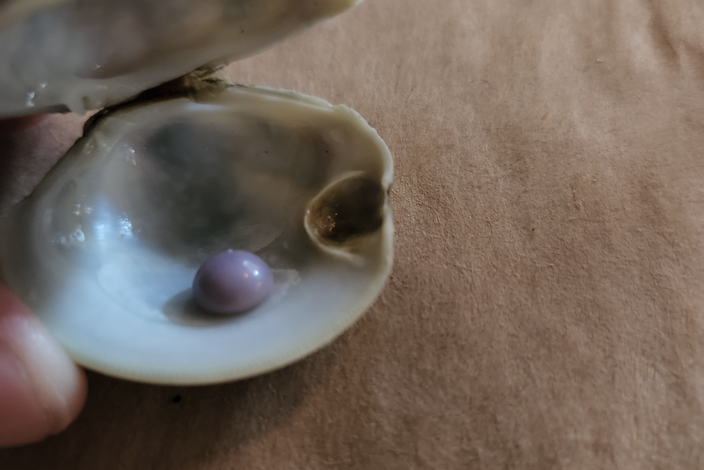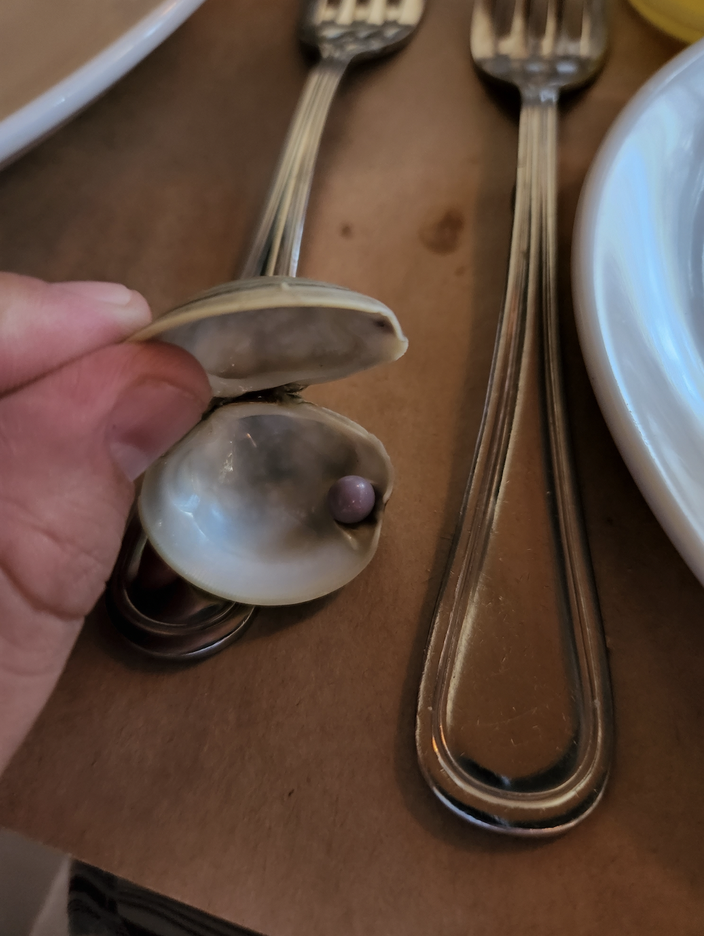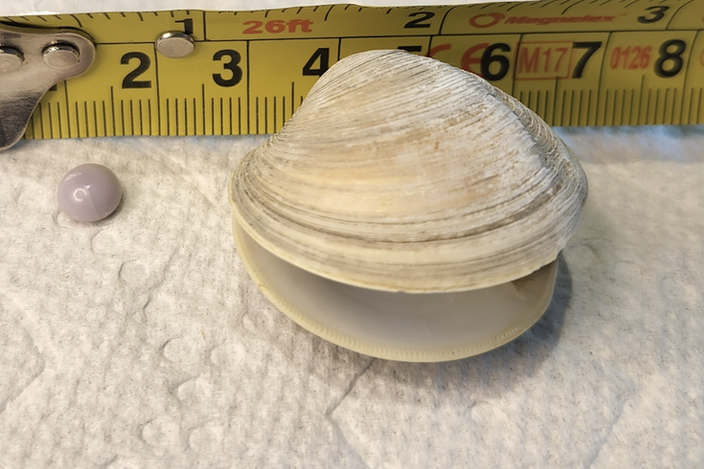
October 03, 2022
 Provided Photo/Scott
Provided Photo/Scott
Scott and Katie Overland, of Phoenixville, found a rare purple pearl in a clam appetizer they ordered in August at Salt Air Kitchen & Bar in Rehoboth Beach, Delaware. The item has since been appraised at $4,071.
The Chester County couple who found a purple pearl in their clam appetizer over the summer have received an appraisal of $4,071 for the rare specimen they encountered while vacationing in Rehoboth Beach.
In August, Scott Overland was dining with his wife, Katie, at the upscale Salt Air Kitchen & Bar at the popular Delaware shore destination. Katie wasn't a big fan of the bell pepper garnish on the clams, which the couple had asked to have removed from the order, but instead of sending the $14 dish back, they decided to roll with it.
"As I was eating the clams, I bit down on something hard and thought it was a piece of shell. When we looked at it, it was actually purple," Scott Overland told PhillyVoice in August. "We initially thought it was something a chef had dropped in like a bead or piece of candy. My wife said it looked like one of those dots candies that you peel off of paper, because the back of it was flat and it was a very light shade of purple."
But when the Overlands looked at the shell the object had come from, they noticed an indentation that suggested a pearl might have grown there.
The discovery of the purple pearl drew a wave of press for the Overlands, who became part of the tiny fraction of diners who happen to luck into a valuable gem. The only remaining question was how much it might be worth, since the Overlands' basic Googling gave them a range anywhere from a few thousand dollars to as much as $16,000.
"It's a pretty rare thing to have in this world, and they're super lucky that they found it and didn't swallow it, or break it with their teeth," said Josh Hyman, whose Philadelphia Jewelry Appraisers in Center City put a value on the pearl. "This one is attractive. It's a decent shape. It's not an oddball shape. It's got a uniform, nice purple color. It's a really cool piece."
The pearl found in the Overlands' clam appetizer is non-nacreous, which means it can only be produced naturally.
The Overlands first had to take their pearl to the Gemological Institute of America to have it authenticated in a lab.
"There are very few people in the world who can say that they're experts in the field of clam pearls or natural pearls," Hyman explained. "They're usually in academia or in laboratories around the world."
The GIA's testing methods include the use of a Fourier Transform Infrared Spectrometer, which can detect the properties of a wide range of gemstones. The report the Overlands received from the GIA — which is valid worldwide — identified their item as a natural pearl from a northern quahog clam, a saltwater species. The pearl weighs in at 1.49 karats and measures 6.95 x 4.10 millimeters.
The purple pearl came from a northern quahog clam in the Chesapeake Bay.
The Overlands' pearl is considered non-nacreous. These tend to have a more porcelain-like appearance and fragile structure, compared to the crystalline structure of nacreous pearls, which have a more lustrous appearance under light. The rarity of non-nacreous pearls often makes them more valuable because they are only produced naturally, whereas many gem-grade, cultured, nacreous pearls are grown and harvested.
Salt Air Kitchen & Bar's supplier, Ballard Clams and Oysters, gets its northern quahog clams from Cherrystone Aqua Farms in the Chesapeake Bay. The species produces non-nacreous pearls that range in color from white to brown and various shades of purple. Usually, they're more flat than spherical, and the GIA report for the Overlands' pearl describes theirs as button-shaped.
"I know it's rare because I know how many clams are eaten in the world every year, and how many of these items have come to light in the last couple of years," Hyman said. "The numbers are staggering. There are hundreds of millions of clams eaten every year. Between 10-20 of these things have come to the surface in the last decade. The rarity on this is beyond the scope of most things people know exist."
Hyman was able to track down two or three similar pearls that have sold in recent years in order to come up with an understanding of the price per karat. The actual appraisal he gave the Overlands is an insurance appraisal, rather than a clear price for the pearl on the marketplace. The Overlands can add the pearl to their homeowners insurance policy, typically at about 1-2% of the item's value per year.
"We are definitely going to keep it," Overland said Monday. "It has just become such a fun, special story and memory for us — I don't know how we could sell it at this point! The tough decision now is whether we turn it into a piece of jewelry or keep it 'as is,' and maybe make a display case for it with the shell."
Hyman explained that an actual sale price for the Overlands' pearl is especially difficult to predict since the item is so rare.
"You're beholden to what's available in the market," Hyman said. "This is not a real market because 10-20 per decade doesn't constitute a market. It's that rare. Sometimes rarity doesn't equate to value. A large diamond might be less rare than this pearl, but there are a lot more people who would buy that large diamond than this pearl."
If the Overlands ever do decide to sell the pearl, they'll most likely be subject to the magic of an auction.
"I think that the beautiful thing about an auction is it's an unknown end," Hyman said. "Depending on the circumstances of the day, how good the press is around the item that's being sold, and how crazy a couple different buyers who want to compete with each other are, it could sell for a lot more than my appraisal number. It could also sell for a lot less. It just depends on that moment."
For now, the Overlands are happy to have such a unique keepsake and a great story to tell about it. They've learned a lot about pearls as a result of getting it appraised.
"The coolest thing about the appraisal process was getting to see it up close under the microscope," Overland said. "Surprisingly, the bottom side of it was the most fascinating — you could see where it attached to the shell and it had this beautiful sparkle."
 Provided Photo/Scott Overland
Provided Photo/Scott Overland Provided Photo/Scott Overland
Provided Photo/Scott Overland